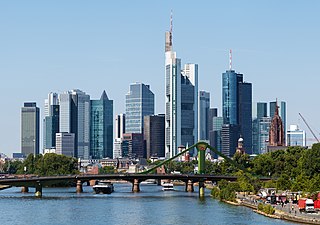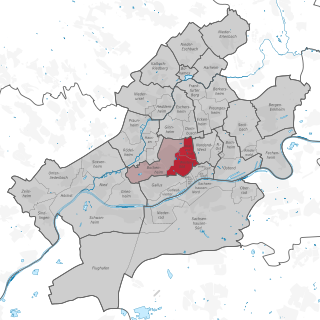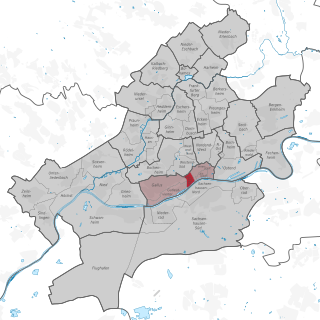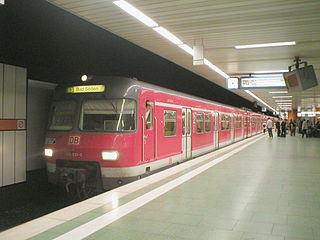
Frankfurt, officially Frankfurt am Main, is the most populous city in the German state of Hesse. Its 763,380 inhabitants as of 31 December 2019 make it the fifth-most populous city in Germany. On the river Main, it forms a continuous conurbation with the neighboring city of Offenbach am Main and its urban area has a population of 2.3 million. The city is the heart of the larger Rhine-Main Metropolitan Region, which has a population of 5.5 million and is Germany's second-largest metropolitan region after the Rhine-Ruhr Region. Frankfurt's central business district lies about 90 km (56 mi) northwest of the geographic center of the EU at Gadheim, Lower Franconia. Like France and Franconia, the city is named after the Franks. Frankfurt is the largest city in the Rhine Franconian dialect area.

The Altstadt is a quarter (Stadtteil) of Frankfurt am Main, Germany. It is part of the Ortsbezirk Innenstadt I.

The Hauptwache is a central point of Frankfurt am Main and is one of the most famous plazas in the city. The original name Schillerplatz was superseded in the early 1900s. It lies to the west of Konstablerwache with both squares linked by the Zeil, the central shopping area of the city.

Westend-Nord and Westend-Süd are two city districts of Frankfurt am Main, Germany. The division into a northern and a southern part is mostly for administrative purposes as the Westend is generally considered an entity. Both city districts are part of the Ortsbezirk Innenstadt II.

The Bahnhofsviertel is a quarter of Frankfurt am Main, Germany. It is part of the Ortsbezirk Innenstadt I.

The Opernplatz is a central city square in Frankfurt, Germany, located in the district of Innenstadt and within the central business district known as the Bankenviertel. The Opernplatz is the most central square of the Bankenviertel. It is named for the Alte Oper building, which today serves as a concert hall. The Sofitel Frankfurt Opera hotel is located at Opernplatz 14. The Opera Quarter with some of Germany's most well known luxury shopping streets is located to the east of Opernplatz.
The U-Bahn Line B is the second line in the network of the Frankfurt U-Bahn. It leads in west-east direction from the central railway station (Hauptbahnhof) over the old town to Konstablerwache, where it splits into two branches to Bornheim and Preungesheim. Originally planned as an independent main line, the D line represents an extension of the U4 to Bockenheimer Warte from the central railway station.

Bankenviertel is the name of the central business district in Frankfurt, Germany. It designates an area in the city centre where many banks, insurance companies, and other financial institutions are located. It is the most important financial centre in Germany and one of the largest in Europe along with La Défense in the Paris aire urbaine and London's City and Canary Wharf.

The Frankfurt Marathon is a marathon which has taken place every year in Frankfurt am Main since its inception in 1981. It is the longest-established city marathon in Germany and in terms of the number of finishers, Germany's second-largest. It is organised by the agency motion events.

The Frankfurt am Main tramway network is a network of tramways forming a major part of the public transport system in Frankfurt am Main, a city in the federal state of Hesse, Germany.
Eschenheimer Turm was a city gate, part of the late-medieval fortifications of Frankfurt am Main, and is a landmark of the city. The tower, which was erected at the beginning of the fifteenth century, is at once the oldest and most unaltered building in the largely reconstructed Frankfurter Neustadt, now better known as the Frankfurt-Innenstadt.

The Frankfurt City Tunnel is standard gauge railway in Frankfurt and the core of the Rhine-Main S-Bahn. The line runs underground for its entire length.

Frankfurt (Main) Hauptwache station is a major train station in the city centre of Frankfurt, Germany.

Frankfurt am Main Konstablerwache station is a major train station and metro station at the Konstablerwache square in the city centre of Frankfurt am Main, Germany.

Konstablerwache is a central square in the centre of Frankfurt am Main and part of its pedestrian zone. It lies to the east of Hauptwache with both squares linked by the Zeil, the central shopping area of the city.

The Line C is a line on the Frankfurt U-Bahn. It consists of the U6 and the U7.

The Kaiserhofstraße (4–19) is a short, mostly pedestrian upmarket street in the city centre of Frankfurt, Germany, located in the Opera Quarter in the western part of the district of Innenstadt, within the central business district known unofficially as the Bankenviertel.

Freßgass is an upmarket shopping street in the city centre of Frankfurt, Germany, located in the district of Innenstadt and within the central business district known as the Bankenviertel. It is commonly regarded as Frankfurt's culinary main street. The street is a broad pedestrian zone, and is located between Hochstraße and the Opernplatz with the Alte Oper in the west and the Börsenstraße with the Frankfurt Stock Exchange in the east. The street is also the direct continuation of the Zeil, and is a parallel street of Goethestraße, Germany's best known luxury shopping street. In recent years Freßgass has increasingly become a luxury shopping street, serving as an extension of the Goethestraße in this regard. Its other primary adjacent street is the Kaiserhofstraße.

Goethestraße is a luxury shopping street in the city centre of Frankfurt, Germany, located between Opernplatz and Börsenstraße and Goetheplatz in the district of Innenstadt and within the Opera Quarter and the broader central business district known as the Bankenviertel. It is a parallel street of Freßgass and located in the immediate vicinity of Kaiserhofstraße. The street is Germany's third-busiest luxury shopping street.

The Hochstraße is a short street in the city centre of Frankfurt, Germany, located in the Opera Quarter in the western part of the district of Innenstadt, within the central business district known unofficially as the Bankenviertel.






























